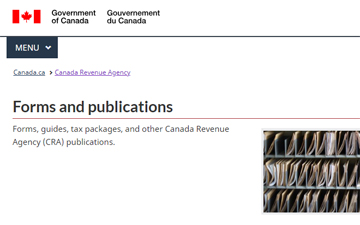Are CRA publications clear and easy to understand? Can Canadian taxpayers trust their information?

Canadian tax lawyer and accountant David J Rotfleisch explains why taxpayers should not necessarily trust CRA publications such as folios, bulletins and circulars
 |
David J Rotfleisch, CPA, JD is the founding tax lawyer of Taxpage.com and Rotfleisch & Samulovitch P.C., a Toronto-based boutique tax law corporate law firm. |
Who determines the correct tax treatment when interpreting a particular income tax provision?
The provisions in the Income Tax Act can be exceedingly difficult to interpret for those who are not accustomed to the language used by the legislature. The provisions also do not set out how to apply each provision in practice, which can potentially confuse a taxpayer who is trying to understand how the provision applies to his or her situation. For this reason, the Canada Revenue Agency releases publications in an attempt to educate taxpayers. These publications can take the form of guides and pamphlets, tax forms and schedules, news releases and tax alerts, GST/HST memoranda, information circulars, and CPP and EI regulations.
In general, the correct tax treatment is determined by looking to the relevant provisions in the Canadian Income Tax Act, and looking to tax court decisions on the matter. This means that while CRA publications can be looked to for guidance, the publications are not legally binding and they do not consider the tax treatments of each taxpayer's specific situation. In addition, while the CRA is responsible for enforcing and administering the Income Tax Act, it's not responsible for interpreting the Income Tax Act. As such, to interpret the law as written in the Income Tax Act one must look to the binding authority in the case law or consult with a tax lawyer. However, note that even though the CRA itself is not bound by its own publications, they nearly always follow them.
The tax auditor is not bound by the CRA's previously issued guidelines when conducting an audit on your tax returns. The doctrine of estoppel cannot be invoked to prevent the CRA from issuing an assessment that contradicts a previously issued ruling or other document. This principle was established by the Supreme Court of Canada in the case of Stickel v MNR. The final say is always with the Tax Court and appeal courts, and while these courts occasionally consider CRA publications in their judgment, these CRA publications do not always accurately reflect the tax issues in question. Tax laws can be exceedingly complex and are changed frequently, so the nuances of their application may not be fully captured by a published ruling or other CRA-issued publication.
The CRA provides guidance in the form of income tax folios
Income tax folios, also known as tax folios, are comprehensive and authoritative documents that offer detailed explanations and interpretations of various provisions of the Canadian Income Tax Act. The purpose of these folios is to assist taxpayers, tax professionals and CRA personnel in understanding and applying the tax laws correctly.
Folios cover a wide range of topics, including specific tax rules, concepts, and transactions. They aim to provide guidance on the interpretation of tax legislation and how it applies in different situations. These publications often include examples, case law references, and explanations to illustrate the application of the tax laws.
Folios are regularly updated by the CRA to reflect changes in tax legislation, new court decisions, and developments in tax policies. They are considered valuable resources for taxpayers and Canadian tax professionals as they offer insights into the CRA's interpretation of tax laws and can help in understanding complex tax issues and tax planning strategies. However, it's important to remember that folios are for general guidance purposes only and should not be considered as legal advice as they are not legally binding, as explained above.
The CRA also provides guidance in the form of interpretation bulletins
CRA interpretation bulletins are publications that provide guidance on the interpretation of specific provisions of the Canadian Income Tax Act and other tax-related laws. In 2013, the CRA introduced income tax folios, gradually phasing out the income tax interpretation bulletins. Several outdated bulletins have already been canceled, and the remaining bulletins are still available until their technical content is updated and published into an income tax folio. These bulletins are issued by the CRA to help taxpayers, Canadian tax professionals, and CRA personnel understand the tax laws and how they apply to different situations. Interpretation bulletins typically focus on a particular aspect of tax law or address specific tax issues. They offer explanations, examples, and references to relevant tax legislation and court decisions to illustrate how the CRA interprets and applies the law.
Unlike income tax folios, which are comprehensive and cover a wide range of topics, interpretation bulletins are more targeted and specific in their scope. They are used to clarify the CRA's position on particular tax matters and may be updated periodically to reflect changes in tax laws or new developments in tax policies. Interpretation bulletins are available on the Canada Revenue Agency's website and can be accessed by taxpayers, tax professionals, and the general public. One should be extra cautious when reading an interpretation bulletin, as these were not published and updated as recently as income tax folios, so their content could potentially be obsolete.
The CRA's website explains that:
Taxpayers and their representatives may continue to refer to the interpretation bulletins for explanations of the CRA's interpretation of federal income tax law, keeping in mind the caution that has always applied: While the comments in a particular paragraph in an interpretation bulletin may relate to provisions of the law in force at the time they were made, such comments are not a substitute for the law. The reader should, therefore, consider such comments in light of the relevant provisions of the law in force for the particular taxation year being considered, taking into account the effect of any relevant amendments to those provisions or relevant court decisions occurring after the date on which the comments were made.
As always with CRA publications, these publications are valuable resources for understanding the CRA's interpretation of tax laws, but they should not be considered as legal advice.
Information circulars and published rulings
Information circulars are documents that provide detailed explanations and interpretations of specific tax laws and regulations. They aim to provide guidance to taxpayers, tax professionals, and other interested parties on various tax-related matters. These circulars typically provide examples, calculations, and case studies to illustrate how the tax laws and regulations are applied in specific situations. They are a valuable resource for taxpayers and tax professionals to understand their tax obligations and rights under Canadian tax law. Like the other forms of guidance issued by the CRA, they are not legally authoritative documents.
A published ruling is a ruling issued by the CRA that has been officially published and made available to the public. A published ruling from the CRA typically provides guidance and interpretation on various tax laws, regulations, and policies. These rulings are meant to help individuals, businesses, and tax professionals understand how the CRA interprets and applies tax laws in specific situations, and can give the taxpayer an advance idea of how the CRA will view one's actions.
Tax auditors may make mistakes even when interpreting CRA publications
When a notice of objection is sent to the CRA in response to a notice of assessment or reassessment, the CRA tax auditors that review these notices of objection are not lawyers and do no have substantial legal training. This means that, as with CRA publications, their word is not the law, and could very well be a misinterpretation of the complex provisions in the Income Tax Act or even a misinterpretation of the CRA position.
While there are extensive resources online for tax-related legal matters to supplement CRA publications, these resources do not take into account the facts and circumstances of each individual taxpayer. An analysis of these facts and circumstances are vital to arriving at a principled legal conclusion in any tax matter. The CRA tax auditor could very well misapply the law to those facts and circumstances of a taxpayer, or arrive at a conclusion that is not supported by the facts.
David J Rotfleisch, CPA, JD is the founding tax lawyer of Taxpage.com and Rotfleisch & Samulovitch P.C., a Toronto-based boutique tax law corporate law firm and is a Certified Specialist in Taxation Law who has completed the CICA in-depth tax planning course. He appears regularly in print, radio and TV and blogs extensively.
With over 30 years of experience as both a lawyer and chartered professional accountant, he has helped start-up businesses, cryptocurrency traders, resident and non-resident business owners and corporations with their tax planning, with will and estate planning, voluntary disclosures and tax dispute resolution including tax audit representation and tax litigation. Visit www.Taxpage.com and email David at david@taxpage.com.
Read the original article in full on Taxpage. Title image: iStock. Author photo courtesy Rotfleisch & Samulovitch P.C.










(0) Comments